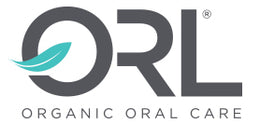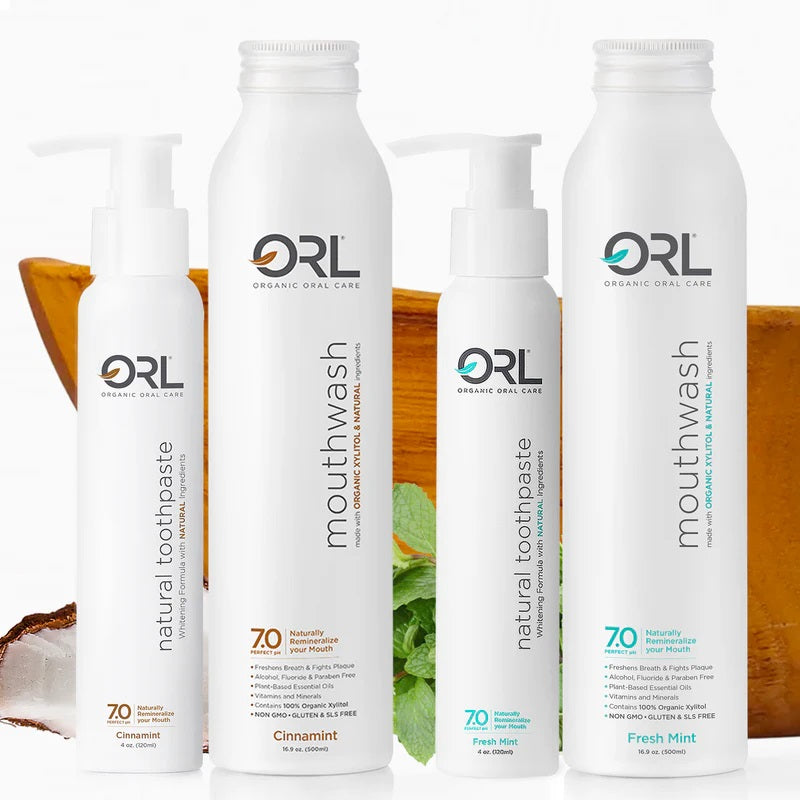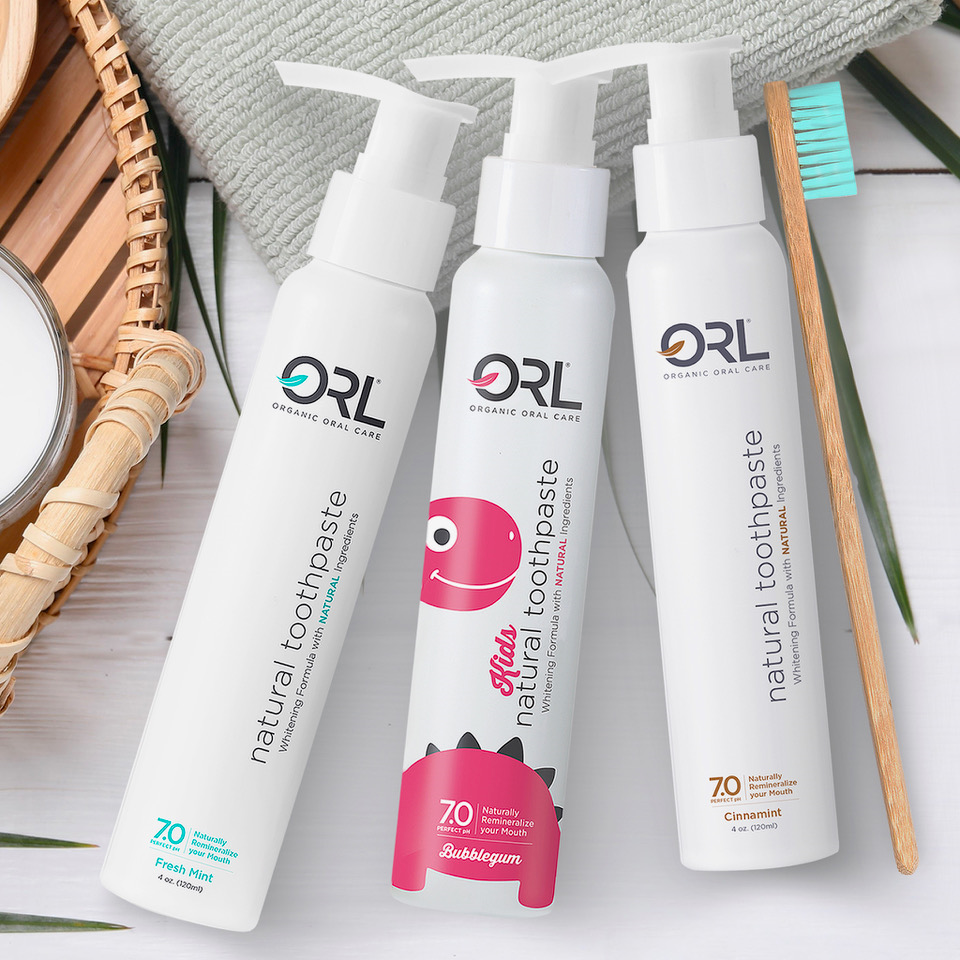Why Use Xylitol Toothpaste and Mouthwash: The Science Explained
Xylitol is a bit of an unsung hero in the dental world. Researchers have known for decades that it has strong cavity-fighting properties, but the dental community was slow to embrace it. Being the pragmatic individuals they are, they held off until there was “substantial” evidence of its effectiveness before jumping on the bandwagon. The end result was that we saw a huge surge of xylitol-containing products only a matter of years ago—gums, candies, baked goods, toothpastes, mouthwashes, and more. The “breaking news” made headlines at the time, but the fanfare quickly died down. That’s unfortunate because xylitol really is amazing and literally has the ability to cut decay risk down to almost nothing, and instead of it going mainstream, it became up to individuals to educate themselves on its benefits and to mindfully seek out xylitol-containing products.
On this page, we’re going to help you kick-start that process. We’ll start with a breakdown of the traits a healthy mouth possesses, explore how our everyday lives contribute to disease and decay, and then get into how xylitol functions on a scientific level to address the mechanisms which can lead to oral health problems.
A Healthy Mouth is a Balanced Ecosystem
Most of us don’t think about our oral health until we’re preparing for a dental checkup. Sure, about 70% of us brush like we should, according to surveys carried out by Delta Dental, but only about 40% of us floss. It’s not surprising that research shows as much as 80% of the population has some degree of dental anxiety. Of course we’re worried. Going in means we could be diagnosed with cavities or periodontal disease. At the same time, our logical brains know that climbing into the chair for an exam isn’t what changes things—it’s the steps we take beforehand that matter. It’s whether or not we’ve maintained an oral environment that promotes health.
Healthy Mouths Have Bacteria
We often associate bacteria with bad breath, decay, and disease, but not all bacteria contribute to these conditions. About 45% of the bacteria in our mouths follows through the entire digestive chain, researchers say, and considerably more of it makes at least part of the way through. We know our bodies rely on these bacteria; just think about what happened the last time you took an antibiotic. You probably wound up with a whole host of gastrointestinal issues until beneficial bacteria had a chance to build back up. Similar mechanisms are at play in your mouth too. Data from the National Institutes of Health (NIH) indicates as many as 700 strains of bacteria are known to live in the human mouth, with the average person having somewhere between 250-300 at any given time. Many are essential for digestion, but as Deborah Franklin of Scientific American points out, some promote oral health too. Streptococcus salivarius K12, for example, actually keeps cavity-causing bacteria at bay.
Saliva Sets the Stage for Wellness
Enamel is the hardest substance in the human body and has the highest concentration of minerals too. Calcium and phosphate are two of the most dominant. Unfortunately, these minerals don’t always stay put. The process of them leeching out is known as demineralization, which weakens teeth and makes them more susceptible to decay. Thankfully, saliva is loaded with minerals that can replenish those lost. Under the right conditions, remineralization naturally occurs and our fortified teeth remain resistant to decay. Bacteria are present in saliva too, which, again, is beneficial, as certain types of bacteria help the digestive system and combat cavities. Of course, the bulk of our saliva is water, so it also pulls the “gunk” in our mouths away from our teeth and gums and sends it through the digestive system and contributes to a healthy environment.
A Neutral pH Level Diminishes Bad Bacteria and Allows for Remineralization
One often overlooked component of oral health is pH levels. In chemistry, the pH scale is used to measure whether a substance is an acid or a base. Although some scales dip below 1.0 to denote seriously acidic substances, like battery acid, which rates a 0, most go from 1-14. A pH of 7.0, therefore, is right in the middle. It’s considered “balanced” or “neutral.” Our bodies thrive with a neutral pH. In fact, studies have shown that moving even a modest amount in either direction can spell out trouble.
When it comes to oral health, a pH of 6.2-7.6 is normal. However, researchers found that those with a more acidic oral pH usually have periodontitis, also known as periodontal disease or advanced gum disease. Individuals with periodontitis have an average oral pH of 6.85. Possessing a more alkaline oral pH isn’t good either, as those with generalized gingivitis, also known as early-stage gum disease, have an average pH of 7.24. In these cases, pH isn’t just a predictor of health or disease, it’s actually a major component of a complex system. Bacteria thrives in an acidic environment, and acidic environments encourage demineralization. In fact, your teeth will not remineralize unless they’re in a neutral environment. Ergo, the closer your oral pH is to neutral, the stronger your teeth will become and the less you’ll experience decay and gum disease.
Oral Health Problems Begin When Balance is Lost
As you can see, bacteria, saliva, and pH are all necessary to create a healthy oral ecosystem. Furthermore, when one area has issues, it contributes to issues within the other components. Not surprisingly, about half of all Americans over age 30 have some form of gum disease, per the Centers for Disease Control (CDC), and prevalence increases with age.
Gingivitis is the First Warning Sign
All people develop biofilm in their mouths. Also referred to as plaque, this sticky substance is the home of bacteria. Its presence is a major irritant to gums, but it also makes saliva more acidic, thus increasing demineralization and decay risk. Plaque is soft and easy to remove at home with brushing and flossing if you address it regularly, but it hardens into tartar, also called calculus. Calculus can form on any surface of your teeth—even below the gumline, and can only be removed by a dental professional. This is why we’re advised to get professional cleanings at least every six months. Some symptoms of early-stage gum disease (gingivitis) include:
- Bad breath
- Irritation
- Sensitivity
- Bleeding while brushing and flossing
If Untreated, Gingivitis Will Develop into Periodontitis
Naturally, the buildup of bacteria and plaque isn’t good for your teeth and gums. As irritation and calculus take over, gums pull away from teeth, creating pockets. The pockets then offer bacteria a perfect environment to grow in, resulting in the development of localized infections. This contributes to bone loss in the areas where infection is present and ultimately results in tooth loss. Dentists can provide therapeutic treatment which eliminates infection and buildup, giving the gums a chance to regain health, but bone loss can only be repaired with surgery. To recap, symptoms of advanced gum disease (periodontitis or periodontal disease) include those associated with gingivitis as well as:
- Gum recession
- Pocketing
- Localized infections
- Bone loss
- Tooth loss
Common Habits Undermine Natural Balance
In a perfect world, we’d nurture our healthy bacteria, have plenty of mineral-rich saliva, and we’d maintain a neutral pH. In doing so, gum disease and cavities would probably cease to exist. Unfortunately, our habits and the things we expose ourselves to undermine the natural balance our bodies need.
We Take Medications which Reduce Saliva
Medications can be a necessary part of life, but some contribute to dry mouth, also known as xerostomia. Experts list antihistamines, diuretics, antidepressants, antihypertensives, analgesics, and tranquilizers as major culprits. Doctors and pharmacists typically recommend that people experiencing drug-induced dry mouth switch medications, but this isn’t always a possibility. That means teeth don’t get the mineral bath they need, bacteria thrives, and disease usually sets in. It can, however, be treated in a number of ways.
We Create Acidic Environments
Consider, for just a moment, that coffee has a pH of 5.0, while things like flavored waters, citrus drinks, and soda tend to sit in the 2.0-3.5 range. Ideally, these acidic beverages will only be in our mouths for a brief period of time, but more often than not, we sip on them for a prolonged period (perhaps all day), thus plummeting the pH of our mouths. At the same time, we eat carbohydrate-rich diets, and that includes things like sugars, starch, and cellulose. Bacteria, especially Streptococcus mutans, which is the bacteria associated with tooth decay, breaks the carbohydrates down, releasing lactic, butyric, and aspartic acids into our saliva. This means our teeth demineralize and have fewer opportunities to remineralize.
It’s worth noting that many oral care products, including commonly used toothpastes and mouthwashes, also reduce pH. Many whitening products are even worse, with pH levels as low as 3.67.
We Kill the Good Bacteria Our Bodies Need
People want to control the colonization of Streptococcus mutans, which makes sense, but they do so by using antiseptic rinses and toothpastes. “Although some mouthwashes merely mask unpleasant odors, alcohol-based rinses sold in drugstores and prescription rinses containing chlorhexidine or other antiseptics target all oral bacteria, stinky and otherwise,” explains Scientific American’s Franklin. Generally speaking, the “bad” bacteria recolonize quicker than the “good,” and an unfortunate domino effect takes place.
We Demineralize Our Teeth and Fail to Remineralize
On the one hand, our acidic saliva promotes the loss of minerals and prevents our teeth from remineralizing. But, rather than finding ways to give our teeth the calcium and phosphate they will naturally absorb on their own under the right conditions, we bathe them in fluoride and hope for the best.
We Spread Cavity-Causing Bacteria to Our Children
Perhaps what’s most interesting about this whole phenomenon is that we aren’t only harming our own balance when we do these things, we’re upsetting the balance of our children’s mouths too. Research shows children are not born with Streptococcus mutans and other types of “bad” bacteria. However, as they age, they pick them up. It happens in innocuous situations; a parent shares a bite of food or a sip of a drink. The child then has the parent’s bacteria. Scientists say the “Window of Infectivity” occurs from 6-30 months, with about 20% of children acquiring Streptococcus mutans at 18 months. Further research indicates that the presence of this bacteria at age two is directly linked to the likelihood of a child developing cavities in his or her primary teeth, and that is a predictor of decay in adult teeth. In other words, our own oral health impacts our children’s oral health for the rest of their lives.
Our Oral Health Impacts Our Overall Health
“For a long time it was thought that bacteria was the factor that linked periodontal disease to other disease in the body,” the American Academy of Periodontology (AAP) explains. “However, more recent research demonstrates that inflammation may be responsible for the association.” The AAP, CDC, and Cleveland Clinic link periodontal disease to:
- Diabetes
- Heart disease
- Osteoporosis
- Respiratory disease
- Alzheimer’s disease
- Depression
- Preterm birth (seen in pregnant women with gum disease, which can result in poor outcomes and lifelong consequences for the baby)
- And many more chronic inflammatory conditions
Xylitol Research has Been Ongoing for Decades
A German chemistry professor brought xylitol to the world in 1890 when he separated the compound from beech chips, while a French chemist isolated it from wheat and oat straw just a few months later. It’s a sugar alcohol, which researchers initially concurred could be used as a substitute for sugar. Even still, it was largely overlooked until the 1970s when a new group of researchers realized it had the potential to eradicate decay. They had study participants dine on a diet of xylitol-containing soda, caramels, and sweet rolls for four days and then compared the level of plaque buildup those people had compared to other groups who had sucrose and glucose. The xylitol group had 45-50% less plaque.
Xylitol Addresses Oral Health on Many Fronts
The research conducted in the 1970s kicked up a firestorm and, soon, everyone was conducting xylitol research. Scientists are still enamored with it and continue to explore its uses, benefits, and ideal dosing, but we’ve learned quite a bit about it already.
Xylitol Inhibits Plaque Production
As noted earlier, the first tests on xylitol related to plaque formation. Researchers concluded that xylitol has antimicrobial properties, which inhibits the development of plaque buildup.
Saliva Production Increases with Xylitol
Many studies link xylitol chewing gum with increased saliva production. That’s not necessarily surprising because the mere act of chewing something tells the body to produce more saliva in order to digest it. However, researchers have looked at mouthwashes which contain xylitol too, and these can help increase salivary flow rates and reduce the symptoms associated with dry mouth as well.
Xylitol Can Correct pH, Facilitating Remineralization
Going back to the prior information on acidity and bacteria, Streptococcus mutans is the primary culprit. As it digests carbohydrates, including sugars, acids are created. However, Streptococcus mutans is incapable of digesting xylitol, so it actually causes the bacteria to starve to death. Without the creation of acids, oral pH rises. This has been confirmed in studies. Again, teeth will naturally remineralize with the calcium and phosphate already found in saliva, but they can’t do it in an acidic environment. Introducing xylitol and boosting pH, therefore, can aid in remineralization, thus strengthening teeth so they’re less susceptible to decay.
Xylitol is Associated with Cavity Reduction
Naturally, if the bacteria which causes decay starves to death, it can’t cause decay. However, researchers have verified this too. In fact, the early researchers who did the four-day study immediately followed it with a two-year study. Those in the xylitol group had 80-85% less decay. Researchers in another study looked at the impact xylitol has on children who fit into high-risk groups for decay. More than half of their study participants already had at least one cavity before their third birthday. The researchers determined that if children receive xylitol twice per day as their primary teeth erupt, they’ll have 70% fewer cavities. This in mind, somewhere between 15% and 30% of the population will still get cavities even if they undergo xylitol therapy, but all is not lost. Another study found that when people do get cavities while undergoing xylitol therapy, they’re significantly smaller.
Parents Can Reduce Cavities in their Children by Leveraging Xylitol
Earlier, we talked about how parents sharing bacteria with their children increases the likelihood that their children will have decay—not just in their primary teeth, but in their permanent teeth too. It may not be surprising research, but scientists ran studies on mothers and babies and gave some of the mothers xylitol treatment. They were significantly less likely to pass Streptococcus mutans onto their children.
Enjoy the Benefits of Organic Xylitol Toothpaste and Mouthwashes for Your Whole Family
At ORL, we’ve taken a mindful approach to developing oral care products. Each ingredient we add is specifically chosen because it’s proven to be safe and is associated with specific health benefits. Xylitol is one of those ingredients, but we’ve taken this a step further and gone with organic xylitol. Plus, our toothpastes and mouthwashes are specially designed to offer a perfectly neutral 7.0 pH, and come with a host of vitamins and minerals, so your teeth have the opportunity to naturally remineralize—without the use of fluoride. Best of all, we’ve formulated flavors the whole family will love, from classic mint though bubble gum for the kids, making it easier for you and the ones you love to have the healthy, vibrant smiles you deserve.



